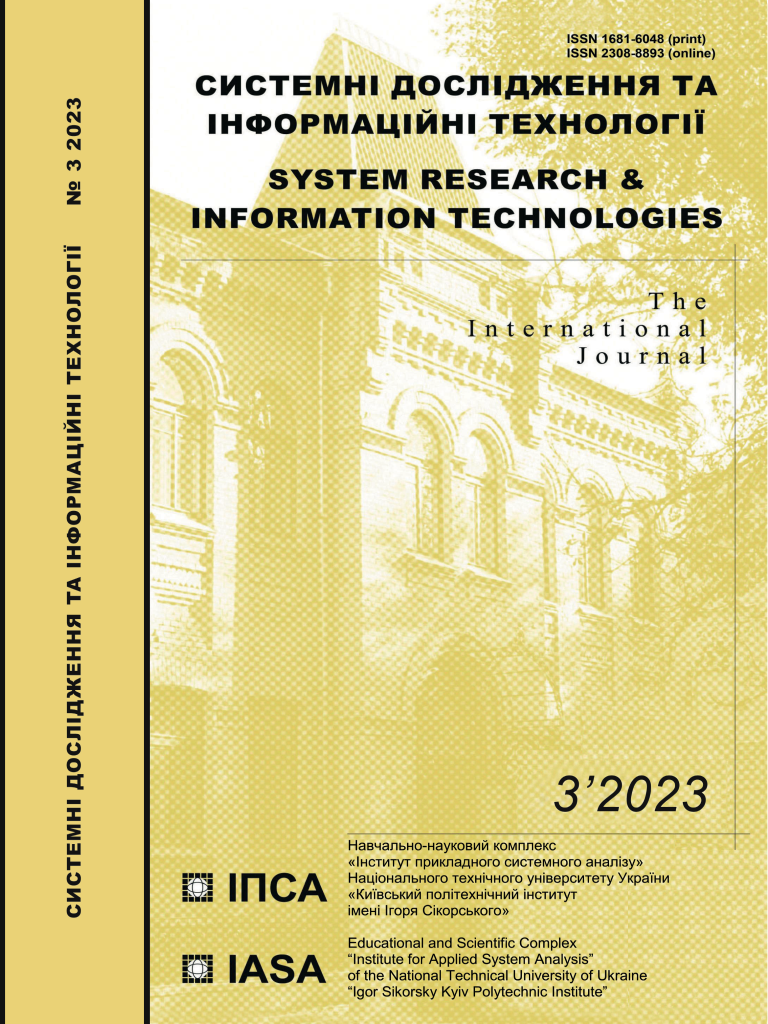Identification of lung disease types using convolutional neural network and VGG-16 architecture
DOI:
https://doi.org/10.20535/SRIT.2308-8893.2023.3.07Keywords:
tuberculosis, pneumonia, Covid-19, VGG-16, convolutional neural networkAbstract
Pneumonia, tuberculosis, and Covid-19 are different lung diseases but have similar characteristics. One of the reasons for the worsening of disease in lung sufferers is a diagnosis that takes a long time. Another factor, the results of the X-ray photos look blurry and lack contracture, causing different diagnostic results of X-ray photos. This research classifies lung images into four categories: normal lungs, tuberculosis, pneumonia, and Covid-19 using the Convolutional Neural Network method and VGG-16 architecture. The results of the research with models and scenarios without pre-trained use data with a ratio of 9:1 at epoch 50, an accuracy of 94%, while the lowest results are in scenarios using data with a ratio of 8:2 at epoch 50, non-pre-trained models, accuracy by 87%.
References
K.F. Budden et al., “Emerging pathogenic links between microbiota and the gut- lung axis,” Nat. Rev. Microbiol., vol. 15, no. 1, pp. 55–63, 2017. doi: 10.1038/nrmicro.2016.142.
P.K. Wang L., F.H. Green, and S.M. Smiley-Jewell, “HHS Public Access,” Susceptibility aging lung to Environ. Inj., vol. 176, no. 1, pp. 539–553, 2010. doi: 10.1055/s-0030-1265895.
D.J. Randall, “Transport and exchange of respiratory gases in the blood | Carbon Dioxide Transport and Excretion,” Encycl. Fish Physiol., vol. 2, pp. 909–915, Dec. 2011. doi: 10.1016/B978-0-12-374553-8.00027-7.
F. Yu, R. Xiao, X. Li, Z. Hu, L. Cai, and F. He, “Combined effects of lung disease history, environmental exposures, and family history of lung cancer to susceptibility of lung cancer in Chinese non-smokers,” Respir. Res., vol. 22, no. 1, pp. 1–10, 2021. doi: 10.1186/s12931-021-01802-z.
N. Clementi et al., “Viral respiratory pathogens and lung injury,” Clin. Microbiol. Rev., vol. 34, no. 3, pp. 1–45, 2021. doi: 10.1128/CMR.00103-20.
U. Grote, A. Fasse, T.T. Nguyen, and O. Erenstein, “Food Security and the Dynamics of Wheat and Maize Value Chains in Africa and Asia,” Front. Sustain. Food Syst., vol. 4, no. February, pp. 1–17, 2021. doi: 10.3389/fsufs.2020.617009.
L.J. Quinton, A.J. Walkey, and J.P. Mizgerd, “Integrative physiology of pneumonia,” Physiol. Rev., vol. 98, no. 3, pp. 1417–1464, 2018. doi: 10.1152/PHYSREV.00032.2017.
R. Gopalaswamy, S. Shanmugam, R. Mondal, and S. Subbian, “Of tuberculosis and non-tuberculous mycobacterial infections - A comparative analysis of epidemiology, diagnosis and treatment,” J. Biomed. Sci., vol. 27, no. 1, pp. 1–17, 2020. doi: 10.1186/s12929-020-00667-6.
M.T. Adil et al., “SARS-CoV-2 and the pandemic of COVID-19,” Postgrad. Med. J., vol. 97, no. 1144, pp. 110–116, 2021. doi: 10.1136/postgradmedj-2020-138386.
L. Morawska and J. Cao, “Airborne transmission of SARS-CoV-2: The world should face the reality,” Environ. Int., vol. 139, no. April, p. 105730, 2020. doi: 10.1016/j.envint.2020.105730.
M. Wei, Y. Zhao, Z. Qian, B. Yang, J. Xi, and J. Wei, “Pneumonia caused by Mycobacterium tuberculosis,” Microbes Infect., no. January, 2020.
“Clinical management of severe acute respiratory infection (SARI) when COVID-19 disease is suspected,” World Health Organization, 2020. [Online]. Available: https://www.ptonline.com/articles/how-to-get-better-mfi-results
R. Yasin and W. Gouda, “Chest X-ray findings monitoring COVID-19 disease course and severity,” Egypt. J. Radiol. Nucl. Med., vol. 51, no. 1, 2020. doi: 10.1186/s43055-020-00296-x.
A.M. O’Hare et al., “Complexity and Challenges of the Clinical Diagnosis and Management of Long COVID,” JAMA Netw. Open, vol. 5, no. 11, p. e2240332, 2022. doi: 10.1001/jamanetworkopen.2022.40332.
A.I. Khan and S. Al-Habsi, “Machine Learning in Computer Vision,” Procedia Comput. Sci., vol. 167, no. 2019, pp. 1444–1451, 2020. doi: 10.1016/j.procs.2020.03.355.
S. Wael, A. Elshater, and S. Afifi, “Mapping User Experiences around Transit Stops Using Computer Vision Technology: Action Priorities from Cairo,” Sustain., vol. 14, no. 17, 2022. doi: 10.3390/su141711008.
S. Arooj, S.U. Rehman, A. Imran, A. Almuhaimeed, A.K. Alzahrani, and A. Alzahrani, “A Deep Convolutional Neural Network for the Early Detection of Heart Disease,” Biomedicines, vol. 10, no. 11, p. 2796, 2022. doi: 10.3390/biomedicines10112796.
Y. Erdaw and E. Tachbele, “Machine learning model applied on chest X-ray images enables automatic detection of COVID-19 cases with high accuracy,” Int. J. Gen. Med., vol. 14, pp. 4923–4931, 2021, doi: 10.2147/IJGM.S325609.
T.N. Sree Ganesh, R. Satish, and R. Sridhar, “Learning effective embedding for automated COVID-19 prediction from chest X-ray images,” Multimed. Syst., no. 0123456789, 2022. doi: 10.1007/s00530-022-01015-4.
S.M. Fati, E.M. Senan, and N. ElHakim, “Deep and Hybrid Learning Technique for Early Detection of Tuberculosis Based on X-ray Images Using Feature Fusion,” Appl. Sci., vol. 12, no. 14, 2022. doi: 10.3390/app12147092.
V. Acharya et al., “AI-Assisted Tuberculosis Detection and Classification from Chest X-Rays Using a Deep Learning Normalization-Free Network Model,” Comput. Intell. Neurosci., vol. 2022, p. 2399428, 2022. doi: 10.1155/2022/2399428.
H. Handoko, F. Rozy, F.E. Gani, and A. Dharma, “Comparative Analysis of Convolutional Neural Network Methods in Detecting Mask Wear,” Budapest International Research and Critics Institute-Journal (BIRCI-Journal), 5(2), 2022.
M. Mujahid, F. Rustam, R. Álvarez, J. Luis Vidal Mazón, I. de la T. Díez, and I. Ashraf, “Pneumonia Classification from X-ray Images with Inception-V3 and Convolutional Neural Network,” Diagnostics, vol. 12, no. 5, pp. 1–16, 2022. doi: 10.3390/diagnostics12051280.
G. Natarajan and P. Dhanalakshmi, “Classification of pneumonia using pre-trained convolutional networks on chest X-Ray images,” Int. J. Health Sci. (Qassim), vol. 6, no. April, pp. 5378–5390, 2022. doi: 10.53730/ijhs.v6ns1.6097.
E. Ayan and H.M. Ünver, “Diagnosis of pneumonia from chest X-ray images using deep learning,” 2019 Sci. Meet. Electr. Biomed. Eng. Comput. Sci. EBBT 2019, pp. 10–13, 2019. doi: 10.1109/EBBT.2019.8741582.
Y.-J. Fan et al., “Machine Learning: Using Xception, a Deep Convolutional Neural Network Architecture, to Implement Pectus Excavatum Diagnostic Tool from Frontal-View Chest X-rays,” Biomedicines, vol. 11, no. 3, p. 760, 2023. doi: 10.3390/biomedicines11030760.

